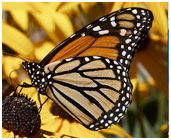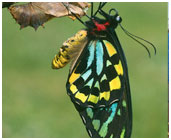The butterfly is a beautiful creature that makes itself quite useful to nature. Check out interesting facts and amazing information about the butterfly.
Facts About Butterfly
One of the most beautiful creatures that have inspired paintings and poetry is the butterfly. It is an insect that belongs to the Lepidoptera order. Butterflies are known for their unusual life cycle that begins with the caterpillar stage, the unique pupa stage and finally the stunning transformation into a beautiful adult butterfly. They are useful to the nature because of the fact that they help in the pollination of plants. Butterflies attract attention because of their vibrant wings and graceful flight. Some butterflies are known to travel and migrate large distances. There are essentially three categories of butterflies: True Butterflies (superfamily Papilionoidea), Skippers (Superfamily Hesperioidea) and Moth-Butterflies (Superfamily Hedyloidea). Most butterfly species are diurnal i.e. they are day-flying insects. The life-span of a butterfly depends on the species it belongs to. Some species can survive only for a week, whereas some others can live for a whole year. Check out amazing facts and interesting information about the butterfly. 

Fast Facts
Kingdom: Animalia
Phylum: Arthropoda
Class: Insecta
Order: Lepidoptera
Superfamily: 3 (Hedyloidea, Hesperioidea, Papilionoidea)
Natural Habitat: Throughout the world (except Antarctica)
Life Span: 1 Week to 1 Year (depending on the species)
Diet: Nectar, Pollen, Rotten Fruits, etc.
Number of Species: Around 24,000
Largest Butterfly: Female Queen Alexandra with wingspan of 26 cm
Interesting and Amazing Information about Butterfly
- The term ‘Butterfly’ is derived from yellow brimstone butterfly of Europe, which is first seen in the ‘butter’ season (early spring). The original name of the butterfly was ‘flutterby’.
- The largest butterflies in the world are the Female Queen Alexandra butterflies. They are found in Papua and New Guinea and have wingspans over 26 cm.
- There are around 24,000 species of the butterfly found worldwide. They are found all over the world and in all kinds of climatic conditions, except the cold and arid region of Antarctica.
- The butterfly can fly up to speeds of 12 miles per hour and cross large distances to migrate. The top speed recorded is that of the monarch butterfly, which is as high as 17 miles per hour.
- The main physical features that re common in butterflies are 6 legs; 1 pair of antenna; segmented body with three parts, namely the head, thorax and abdomen. The butterfly is further divided into 30 orders on the basis of the classification of wings.
- Contrary to popular belief, butterflies can’t taste with their mouth or antenna. In fact, their taste sensors are located right below their feet and they can taste food right by standing on it!
- Many people think the wings of a butterfly get their color from pigments. That is not so. The color is created due to the light reflected on the transparent wing scales of the butterfly.
- Butterflies need the warmth of the sun to fly! They are cold-blooded and incapable of regulating their own body temp erature. They depend on the temperature of their surroundings in order to function. So, if the temperature falls below 55°F, they will not fly.
- Though butterflies are diurnal, but some species like the Northern Pearly Eye can fly at night.
- The only continent where no butterflies have been found is Antarctica.
- Butterflies can identify the colors red, green and yellow.
- An environment or ecosystem is considered healthy and pollution free if there are large number of butterflies.
- Habitat-loss is the biggest threat to butterflies.
- Butterflies breathe through tiny pores in their abdomens called ‘Spiracles’. They do not have lungs.
- Adult butterflies feed on liquids. They usually feed on nectar.
- Butterflies, particularly the male ones, drink from mud puddles. Muddy consists of minerals and salt for which is important for their survival (apart from nectar). They transfer these minerals into the females while coupling which helps increase their fertility.
- Butterflies can see a variety of ultraviolet rays which are invisible to human eye.
- Among all the butterfly species, the Painted Lady is most common and widespread.
- One of the shortest living butterflies is the Spring Azure. It lasts only for a couple of days.
- There are about 17,500 species of butterflies spread throughout world.


See also
More from iloveindia.com
- Home Remedies | Ayurveda | Vastu | Yoga | Feng Shui | Tattoos | Fitness | Garden | Nutrition | Parenting | Bikes | Cars | Baby Care | Indian Weddings | Festivals | Party ideas | Horoscope 2015 | Pets | Finance | Figures of Speech | Hotels in India : Delhi | Hyderabad | Chennai | Mumbai | Kolkata | Bangalore | Ahmedabad | Jaipur
- Contact Us Careers Disclaimer Privacy Policy Advertise With Us Lifestyle Sitemap Copyright iloveindia.com. All Rights Reserved.





